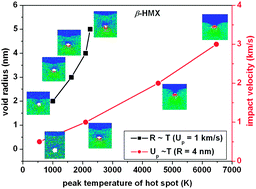Hot spot formation and chemical reaction initiation in shocked HMX crystals with nanovoids: a large-scale reactive molecular dynamics study†
Abstract
We report million-atom reactive molecular dynamic simulations of shock initiation of β-cyclotetramethylene tetranitramine (β-HMX) single crystals containing nanometer-scale spherical voids. Shock induced void collapse and subsequent hot spot formation as well as chemical reaction initiation are observed which depend on the void size and impact strength. For an impact velocity of 1 km s−1 and a void radius of 4 nm, the void collapse process includes three stages; the dominant mechanism is the convergence of upstream molecules toward the centerline and the downstream surface of the void forming flowing molecules. Hot spot formation also undergoes three stages, and the principal mechanism is kinetic energy transforming to thermal energy due to the collision of flowing molecules on the downstream surface. The high temperature of the hot spot initiates a local chemical reaction, and the breakage of the N–NO2 bond plays the key role in the initial reaction mechanism. The impact strength and void size have noticeable effects on the shock dynamical process, resulting in a variation of the predominant mechanisms leading to void collapse and hot spot formation. Larger voids or stronger shocks result in more intense hot spots and, thus, more violent chemical reactions, promoting more reaction channels and generating more reaction products in a shorter duration. The reaction products are mainly concentrated in the developed hot spot, indicating that the chemical reactivity of the hmx crystal is greatly enhanced by void collapse. The detailed information derived from this study can aid a thorough understanding of the role of void collapse in hot spot formation and the chemical reaction initiation of explosives.


 Please wait while we load your content...
Please wait while we load your content...